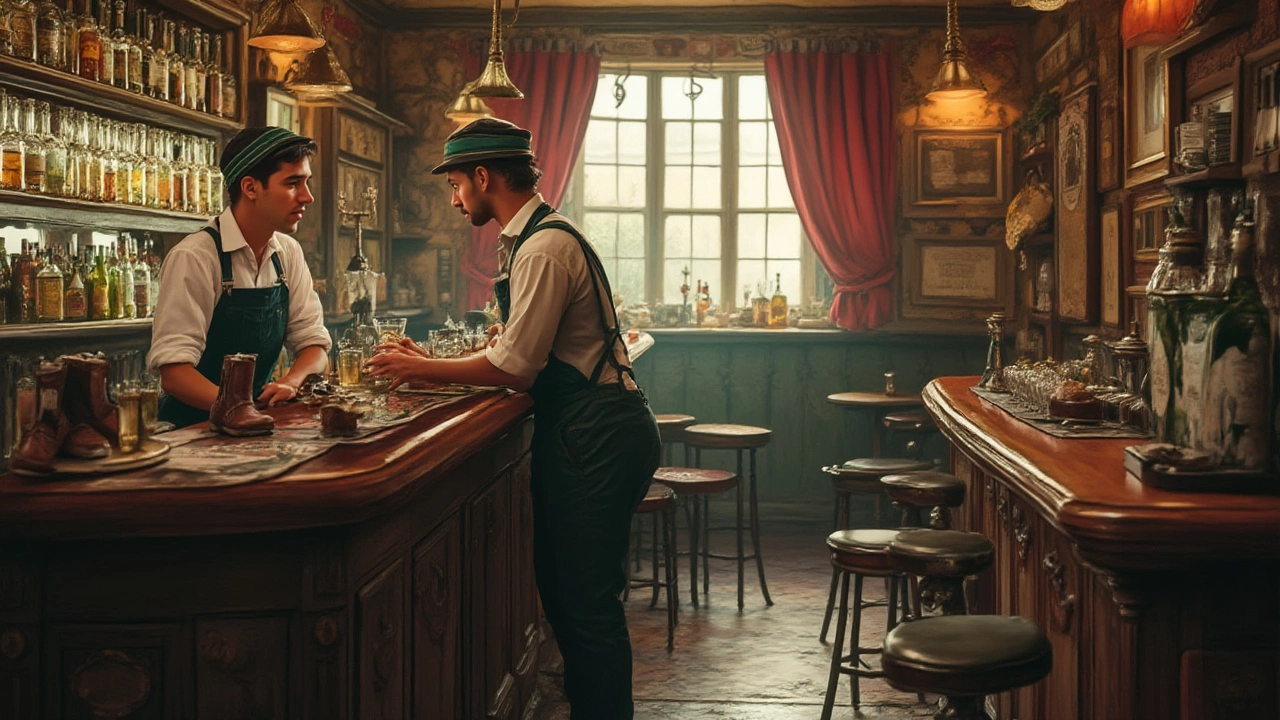If you've ever ended a shift in a Dublin office or after a day touring Cliffs of Moher with blisters and throbbing arches, you know foot pain is nothing to scoff at. In Ireland, where a good chunk of us still walk, stand, or dash about at work—often in unpredictable weather—aching feet can mess with your mood, energy, and even your Guinness plans afterwards. The stubborn cobbles of Temple Bar, wet Donegal footpaths, and Irish work traditions bring their own quirks when it comes to sore feet. Let’s break down how folks across Ireland can keep those dogs from barking by making a few real changes both on and off the clock.
Why Ireland’s Work Life Hits Your Feet So Hard
So, what is it about work in Ireland that gives our feet such a wallop? For starters, lots of jobs here—from retail in Brown Thomas to night security at Galway docks—are heavy on standing and walking. Nurses on the wards at St. Vincent's, baristas serving up flat whites in Cork, teachers pacing around schoolyards: all depend on their feet, often for hours on end. The unpredictable weather, those famously slippery pavements, and even the old-school penchant for sharp, professional shoes all make things tougher.
According to a 2023 study at University College Dublin, nearly 68% of Irish workers in hospitality and healthcare reported moderate to severe foot pain weekly. Nearly half admitted to wearing shoes more for looks than function, especially those under 40. Irish urban centres like Limerick and Waterford still have those cobblestone streets, which may look cute on Instagram but do a number on your instep and heels, especially in heels or flat, thin-soled shoes.
| Factor | Impact on Feet |
|---|---|
| Standing for Long Hours | Swelling, fatigue, pain, arch and heel issues |
| Wet, Uneven Pavements | Slipping, lack of support, twisted ankles |
| Poor Footwear | Blisters, bunions, reduced circulation |
| Infrequent Breaks | Little chance for feet to recover |
Foot pain can sneak up on you, too. At first, it might just be dull aches at the end of a busy day in a Dublin hotel, but over time, it can snowball into chronic problems. Issues like plantar fasciitis or bunions aren’t just for the older crowd either; Irish GPs see these popping up in twenty and thirty-somethings who spend all day in stiff leather brogues or cheap, unsupportive flats. If you think your feet will "just get used to it," you’re probably kidding yourself.
The #1 Foot-Saving Upgrade: Pick the Right Shoes for Irish Weather
First things first: what’s on your feet? A survey by The Irish Foot Health Association in 2024 found over 55% of complaints from workers could be traced straight back to unsuitable shoes. It’s tempting to grab whatever’s closest or goes with your work trousers, but this move can backfire fast. If you’re dashing along Grafton Street or manning the till in a SuperValu, here’s what you should look for.
- Supportive Soles: Forget totally flat shoes. Feet need some arch support to spread pressure evenly. Local shops like Dubarry and Greenes Footwear stock plenty of options that nail both style and comfort. Try trainers that are actually built for standing, not just fashion runners.
- Room in the Toe Box: Irish brands like O’Keeffes specialise in shoes wide enough so toes can move, which is crucial to avoid bunions (and that dreaded pinched feeling).
- Bounce & Cushion: Check for thick, shock-absorbing soles, especially if you’re on concrete. Look for EVA cushioned insoles (available in Elverys or Millets) for instant upgrades. Cork-based foot stores often stock memory foam liners, which make a surprising difference.
- Weatherproofing: Irish weather really is brutal on shoes. Leather is top for water-resistance plus style, but always go for non-slip treads if you work outdoors or navigate wet floors, like in hospitality or healthcare.
- Rotation is Key: Give shoes a break between wears. Alternate pairs daily. This lets shoes dry and bounce back, so they’ll fit and feel better long-term.
Orthopaedic specialists at Bon Secours Hospital swear by custom insoles (called orthotics), especially for folks with flat feet, fallen arches, or old sports injuries. You can get measured at major Irish pharmacies or podiatrist clinics—boots even do basic foot scanning events in larger branches. It’s not just for athletes in Croke Park; anyone who stands a lot will notice the difference.

Tried-and-Tested Foot Pain Relief Tactics from Irish Workers
Once the ache kicks in, what can you do short of lying down with your feet up and refusing to budge? Irish workers have developed a fair share of hacks, some passed down through generations. It’s all about combining traditional wisdom (hello, Epsom salt soaks) with newer fixes that really work.
- Stretch and Move: Simple stretches help a ton. Try toe raises, ankle rolls, and calf stretches on your breaks—even behind a bar at McGettigan’s. Teachers in Dublin primary schools now get students to join in for a mini "foot break," which secretly helps the grownups too.
- Soak and Soothe: When you get in from a wet commuter train, fill a foot basin (some swear by buckets) with warm water and Epsom salts from the local pharmacy. Even five minutes can ease swelling and aches. Add a drop of lavender oil if you’re feeling fancy.
- Chill Out: Swap the warm soak with a cold compress or an ice pack (even a bag of frozen peas wrapped in a tea towel works). It knocks down inflammation and pain after a seriously tough shift.
- Simple Foot Massage: Roll a sliotar or tennis ball under your sole, back and forth while watching Fair City. If you have a partner or teen around, rope them into giving you a quick foot rub with a dab of Irish seaweed oil for bonus points.
- Compression Socks: These are a staple for nurses and retail workers in Cork and Limerick. You’ll find good pairs at pharmacy chains like McCabe’s or online stores like MediLynx—yes, even in cute patterns. They help keep swelling down during long desk or standing shifts.
- Rest (Properly): Putting feet up for ten minutes can do wonders, but get your heels above your heart. Use a stacked cushion or prop up on the arm of your settee, not just flat on the floor. After a night at the pub, it’s worth a try—even if your mates slag you for it.
Every Irish mammy has some trick up her sleeve when it comes to aches and swelling. Mixing a peat mud mask from County Offaly with warm water is a spa trend that's seen a recent revival for feet, thanks to Instagram and a few enthusiastic GAA teams. The point is: look for what’s already worked for generations, but don’t hesitate to try new tools or tech either.
Sneaky Daily Habits to Save Your Feet (Especially in Irish Workplaces)
You don’t need to wait for feet to hurt to treat them well. Prevention works best when it’s built into the workday, rather than something you fix after the damage is done. Even small habits can make a big difference—especially when workplaces are slow to catch up with standing mats or flexible shifts.
- Switch Up Your Position: Take every excuse to move. Step side to side, shift your weight, do mini tiptoes. Hotel staff at Ashford Castle reportedly do quick calf raises and ankle rolls to break up hours on their feet—and it shows in their energy levels.
- Break Smarter: When you break, get off your feet—fully. Don’t stand and chat, sit with feet up. If you’re based in offices like those at Grand Canal Dock, hunt down a spot where you can actually recline, even if it’s just on your bag.
- Drink More Water: Hydrated folks have lower rates of swelling. Irish workplaces are notorious for caffeine rounds and not enough water. A pint of H2O with every break keeps swelling in check.
- Tweak Office Setups: For desk-bound workers, footrests under the desk and anti-fatigue mats matter. Some Irish startups now give standing desk mats as welcome gifts—it’s catching on in tech hubs.
- Foot-Friendly Dress Codes: Don’t be embarrassed to ask HR about more flexible shoe policy—lots of Irish businesses have relaxed footwear rules since 2022, especially after COVID lockdowns and remote work experiments.
- Swap Shoes at Lunch: Stash comfy, arch-support shoes or slippers in your locker to slip on for breaks. Tesco workers in Galway keep soft trainers ready for breakrooms, giving feet a break from dress shoes.
- Regular Foot Checks: Keep an eye on your feet—red spots, irritation, toenail pain. Nipping problems early saves loads of pain down the line. Pharmacies and podiatry clinics in Ireland often run foot health check days (watch for posters or Facebook ads).
Even traditional Irish workplaces—think banks, government offices, or school staffrooms—are gradually shifting their approach to foot health. Group stretching sessions, mats in kitchens for chefs, and more casual dress codes all help. The more workers suggest healthy changes, the faster they’ll catch on, so speak up!

The Little Extras That Make All the Difference for Irish Feet
Think it’s just about shoes and standing habits? There’s more to happy feet than that. Culture, routine, and the little extras give Irish workers a leg up—sometimes literally—on foot pain. And since Ireland is big on community and personal connection, sharing what works actually helps everyone.
- The Irish Pedicure: Not just for women! A trim (no cutting corners), file, and a slather of moisturiser packed with Irish seaweed or lanolin gets those heels healthy. Pharmacies in Sligo stock homemade balms crafted with local lavender, too.
- Monday-to-Friday Shoehorn: Using a simple metal shoehorn from Bewley’s or even a sturdy pint glass (yes, really) helps shoes fit better in a rush—and less tugging means less strain.
- Dry Your Shoes Properly: In Ireland, shoes will get wet. Dry them well. Ball up some newspaper or even a potato skin (another odd Irish trick) to draw out water overnight. Avoid radiators; they ruin the fit.
- Custom Insoles & Local Services: Clinics in Cork and Dublin, like FootWorks, offer custom orthotics. Don’t think it’s just for runners—chefs, teachers, and retail staff benefit, and the clinics often work with private health cover like VHI or Laya.
- Keep Nails Neat: Ingrown nails start small but get nasty, and lots begin from tight shoes or awkward clipping. Book a foot health specialist—Ireland has a growing network, especially in the bigger cities—at least once a year.
- Seasonal Swaps: In winter, switch to lined boots with good grip. Summer calls for more breathable (but still supportive!) shoes—no cheap flip-flops on city sidewalks, if you want pain-free toes.
One thing Irish folk do well is looking after each other. If you’re new to a job or area, ask your colleagues for advice or share your own tricks. Next time you’re stuck swapping war stories about sore feet in the office kitchen or at a GAA match, you’ll have some real tips up your sleeve.
So next time your feet start to burn halfway through a long workday, remember: Irish life is best enjoyed when you’re not limping. Treat your feet as kindly as you’d treat a mate who buys the first round. And keep moving—after all, that’s the Irish way.
